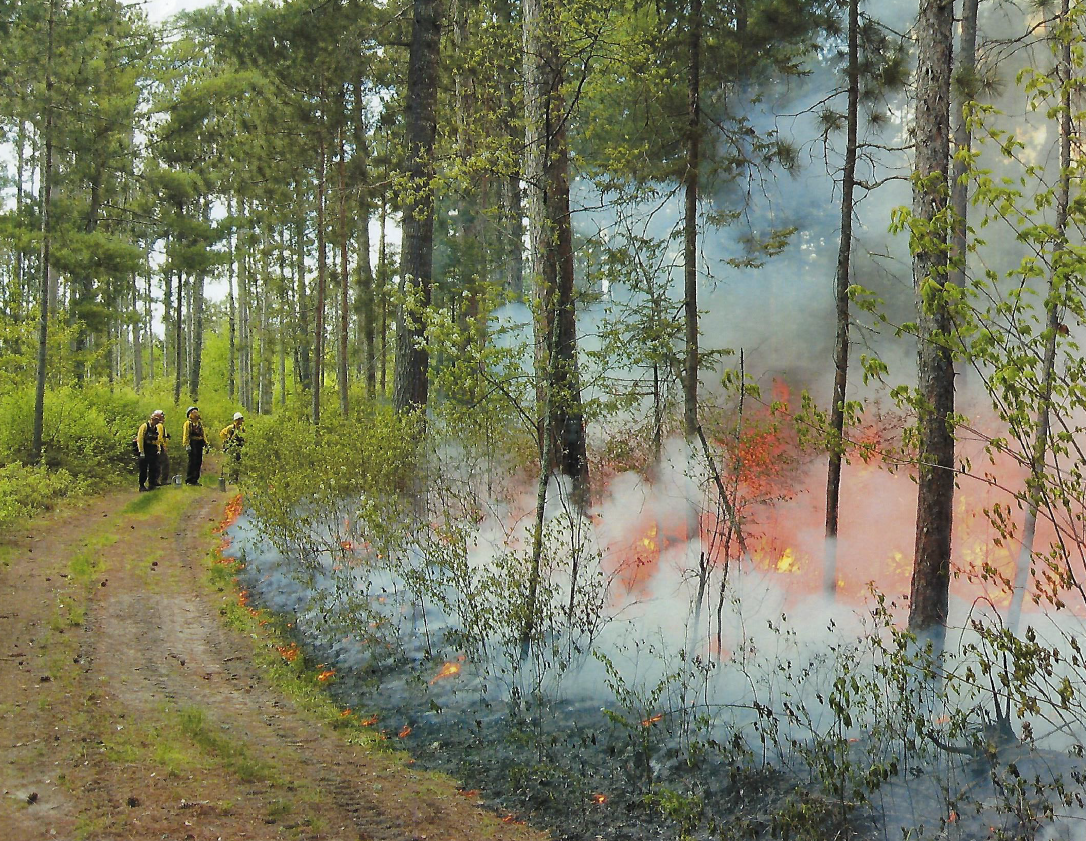Overview
The focus of this study is a multi-year effort to naturally regenerate a mature mixed pine stand to a young pine stand with a significant white pine component through use of prescribed burning and seed tree harvests.
A number of factors influenced the development of the silvicultural prescription for the study site, including:
- A desired future condition from the Chippewa Plains-Pine Moraines and Outwash Plains-Section Forest Resources Management Plan (SFRMP) to increase white pine.
- The site is located on School Trust Land, with resultant authority and responsibility to reduce operating expenses and maximize revenues deposited in the Permanent School Fund; maximize long-term economic returns while maintaining sound natural resource conservation and management principles; and balance short-term revenues and long-term interests so that long-term benefits are not lost in an effort to maximize short-term gains.
- The site is within boundaries of the Leech Lake Indian Reservation, so non-herbicide site preparation and release options were required.
- The prescription was initiated as an “Adaptive Forest Management Project” (AFMP). In 2008, Minnesota Department of Natural Resources (DNR) initiated the AFMP to establish a set of regional forest management field trials/demonstrations. The idea was to demonstrate techniques to improve sustainable forest management in the face of emerging challenges such as climate change, invasive species, and expanding economic opportunities.
The study provides early results for three variations of the number of prescribed burns that were performed (two burns, one burn and no burns) followed by seed tree harvest in all three cases. A “control” area with no treatment was also established for comparison purposes. We intend to update the study with regeneration numbers and condition information over time.
Silviculture Objectives
Desired Future Condition is an uneven-aged, mixed pine site. Specific objectives include:
- Regenerate a stand that will provide revenue to the school trust.
- Use prescribed fire in site preparation, shrub competition control, and duff exposure.
- Favor natural seeding approaches.
- Increase stand structural diversity.
- Increase presence of white pine.
- Reserve biological legacies and encourage natural seeding.
- Stands are within the Leech Lake reservation boundaries, so look for alternatives to herbicide use.
Pre-treatment stand description and condition
Stand establishment and management history
The pre-treatment stand was a natural origin red pine stand. The stand had multiple thinning entries over the past 40 years. The final of these thinnings, before starting the more recent regeneration harvests, took place in 2002.
Pre-treatment stand age: 106 years in 2010.
Pre-treatment basal area = 90 sq. ft/acre.
Pre-treatment species composition
Red pine: Avg. height: 92 ft.
Avg. sawtimber DBH: 19 inches. Volume: 4.6 MBF/acre.
Avg. cordwood DBH: 13 inches. Volume: 11.3 Cds./acre
White pine: Avg. sawtimber DBH: 20 inches. Volume: 4.6 MBF/acre.
Avg. cordwood DBH: 12 inches. Volume: 0.8 Cds./acre
White spruce: Avg. cordwood DBH: 12 inches. Volume: 0.5 Cds./acre
Source: 2009 Minnesota DNR forest inventory
Pre-treatment forest health issues:
White Pine Blister Rust (WPBR)
A recommended strategy for establishing white pine regeneration is to do so under a partial overstory to prevent dew formation on their needles and subsequent infection by WPBR. Once established, seedlings and saplings require tending: pathological pruning and deer browse protection.
White Pine Weevil (WPW)
WPW can repeatedly infest leaders when trees are young, causing stunting, poor tree form, and forking of the stems. WPW attack can be mitigated by planting/ regenerating seedlings under a partial overstory.
Landowner objectives/situation
While specific objectives vary from parcel to parcel, lands under the administration of DNR-Forestry are managed in alignment with Section Forest Resource Management Plans (SFRMP) to ensure that state forest management activities meet statewide goals for ecological protection, timber production, wildlife habitat and cultural/recreational values. The DNR assembles teams from the Divisions of Forestry, Fish & Wildlife, and Ecological & Water Resources who work with partners and the public to develop SFRMPs.
The study area is School Trust Land. Minnesota’s Permanent School Fund receives income from economic activities on School Trust Lands which are managed by the MN DNR. Revenue on School Trust Lands is generated from forest management amongst other activities. Forest management activities on School Trust lands are planned and carried out by MN DNR.
As it relates to forest management on School Trust Lands, MN DNR has the authority and responsibility to achieve the goals outlined in Minnesota Statute, Section 84.027, Subd. 18 including:
- manage efficiently and with undivided loyalty;
- reduce operating expenses and maximize revenues deposited in the Permanent School Fund;
- maximize long-term economic returns while maintaining sound natural resource conservation and management principles;
- balance short-term revenues and long-term interests so that long-term benefits are not lost in an effort to maximize short-term gains;
- maintain the integrity of the trust and prevent the misapplication of its lands and its revenues.
Silviculture prescription
The following series of treatments were implemented:
See Figure 1 for a map of treatment areas.
Activity | Date | Description | Acres Treated | Treatment Label on Map |
Prepare site with prescribed fire. Burn area repeatedly to reduce vigor of hazel and open duff layer for seed germination and seedling establishment. Note: the site is within boundaries of the Leech Lake Indian Reservation, so non-herbicide site preparation and release options were required. | ||||
Rx fire | 2009 | Fire was completed, but no notes were found to document effectiveness for the objectives of setting back shrub (hazel) competition and preparing the seedbed. | 10 | 2 Burns |
Rx fire | 07/16/ 2013 | 70% top kill of hazel. No mortality in residual pine. | 10 | 2 Burns |
Rx fire | 07/16/ 2013 | Very hot burn. 100% top kill of hazel. No mortality in residual pine. | 3 | 1 Burn |
Seed tree with reserves harvest | 2013 | The focus of this harvest was to:
Area to be harvested in August to maximize disturbance to suckering hazel and prepare seed bed.
With the exception of the balsam fir, other species presently on site will be reserved.
Other on-site plant legacies will be preserved in fragments across site due to their proximity to the reserve trees.
Decent white pine cone crop noted. | 13.5 | 1 Burn and 2 Burn |
Hand seeding | 2014 | Hand seeding of white pine was done on 3.5 acres because the residuals are heavier to red pine in this location so adequate white pine seed source didn’t exist. The 20-30 ft2/acre BA of mostly red pine reserve trees here are serving as a shading control to mitigate white pine weevil. | 3.5 | 1 Burn |
Seed tree with reserves harvest on unburned area | 2018 | The focus of this harvest was to:
Area to be harvested in September to maximize disturbance to suckering hazel and prepare seed bed.
With the exception of the balsam fir, other species presently on site will be reserved.
Other on-site plant legacies will be preserved in fragments across site due to their proximity to the reserve trees.
Regeneration goal is by natural seeding of pine from reserved seed trees. A moderate cone crop exists on both the white pine and spruce. Some red pine cone was also noted during the field cruise. Seed drop should occur during harvest operations, which is why the sale is limited to 2 months only.
With the exception of the balsam fir other species presently on site will be reserved.
Other on-site plant legacies will be preserved in fragments across site due to their proximity to the reserve trees.
This cutting unit was not burned but will act as a comparison of different treatments on a FDn33 site. | 11.6 | Non-burned |
Regeneration survey | May/June 2023 | To assess the success of seed tree in unburned area as well as to assess the need for budcapping or stem pruning for WPBR prevention | 25 | 1 Burn, 2 Burn, and Non-burned |
Regeneration survey | 2025 | Release assessment | 25 | 1 Burn, 2 Burn, Non-burned, and Control |
Regeneration survey | 2029 |
| 25 | 1 Burn, 2 Burn, Non-burned, and Control |
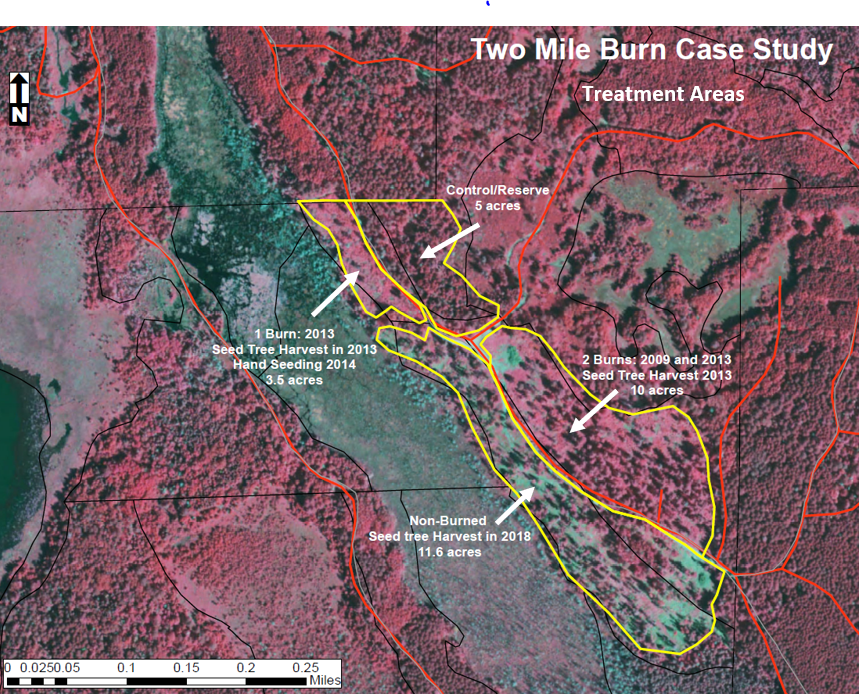
Figure 1: Map of treatment areas
What actually happened during the treatment
Due to a variety of issues, burn windows, etc. only a portion of the stands (the southeastern most 10 acre section) was burned multiple times. There was also no regeneration check in 2023. The treatment otherwise went as prescribed.
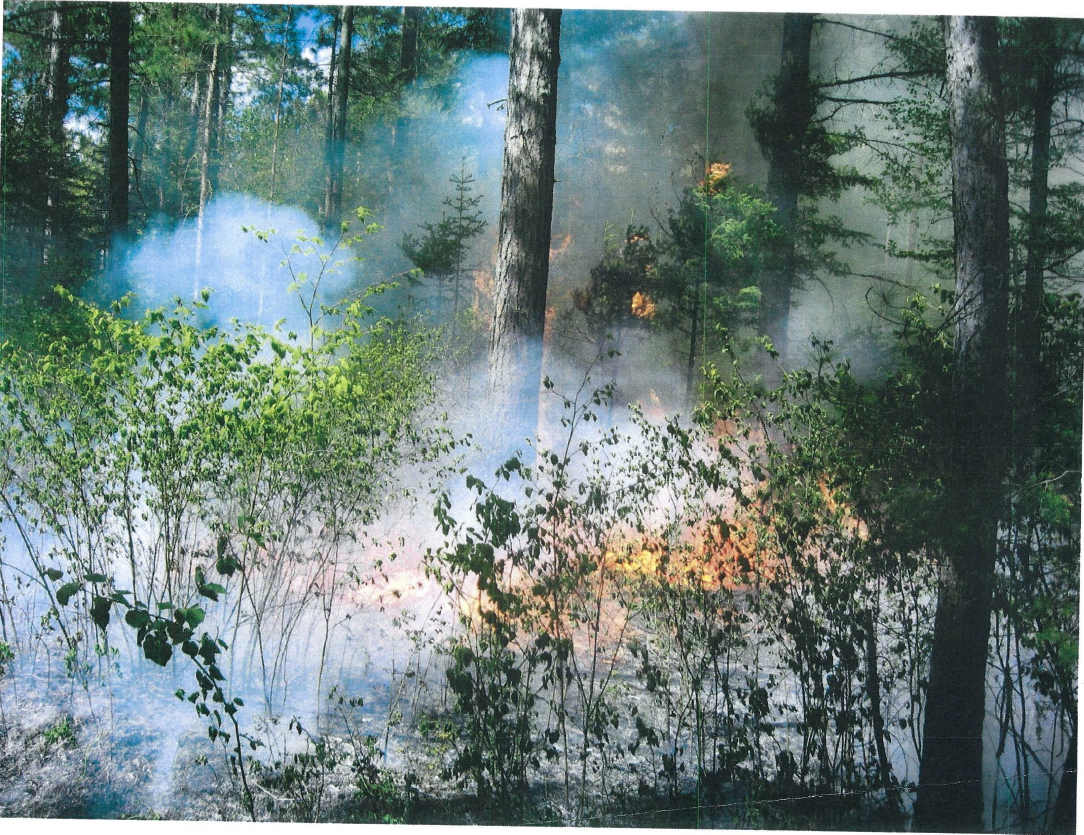
Figure 2: A prescribed burn in progress on one of the case study sites.
Post-treatment assessment
Table 1: October 6, 2020 regeneration check data for the area Rx burned in 2009 and 2013, followed by seed tree harvest August 2014
Treatment: 2 burns in 2009 and 2013, followed by seed tree harvest in fall 2013 October 6, 2020 regeneration check data | ||||
| Stems/acre by size class | |||
Species | (<1' tall) | (<1"dbh, >1' tall) | (1-3"dbh) | (3-5"dbh) |
Balsam fir | 0 | 0 | 0 | 0 |
Black cherry | 0 | 100 | 0 | 0 |
Northern red oak | 0 | 150 | 0 | 0 |
Paper birch | 0 | 100 | 80 | 0 |
Red maple | 0 | 0 | 0 | 0 |
Red pine | 300 | 350 | 0 | 0 |
Tamarack | 0 | 0 | 0 | 0 |
Trembling aspen | 0 | 150 | 30 | 0 |
White pine | 1,000 | 1,150 | 0 | 0 |
White spruce | 0 | 150 | 0 | 0 |
Total | 1,300 | 2,150 | 110 | 0 |
Table 2: October 5, 2020 regeneration check data for the area Rx burned in 2013, followed by seed tree harvest August 2013. *Trembling and big-tooth aspen combined for this site.
Treatment: 1 burn in 2013, seed tree harvest in fall 2013 and hand white pine seeding in 2014 October 5, 2020 regeneration check data | ||||
|
| Stems/acre by size class | ||
Species | <1' tall | (<1"dbh, >1' tall) | (1-3"dbh) | (3-5"dbh) |
Balsam fir | 0 | 0 | 0 | 0 |
Black cherry | 0 | 0 | 0 | 0 |
Northern red oak | 0 | 0 | 0 | 0 |
Paper birch | 0 | 1,125 | 75 | 0 |
Red maple | 0 | 0 | 0 | 0 |
Red pine | 0 | 125 | 0 | 0 |
Tamarack | 0 | 0 | 0 | 0 |
Aspen* | 0 | 875 | 125 | 0 |
White pine | 0 | 0 | 0 | 0 |
White spruce | 0 | 0 | 0 | 0 |
Total | 0 | 2,125 | 200 | 0 |
Table 3: October 6, 2020 regeneration check data for the area not burned, with a seed tree harvest August 2013
Treatment: Non-burned. Seed tree harvest in 2018 October 6, 2020 regeneration check data | ||||
|
| Stems/acre by size class | ||
Species | <1' tall | (<1"dbh, >1' tall) | (1-3"dbh) | (3-5"dbh) |
Balsam fir | 0 | 83 | 33 | 0 |
Black cherry | 0 | 0 | 0 | 0 |
Northern red oak | 0 | 0 | 0 | 0 |
Paper birch | 0 | 250 | 17 | 0 |
Red maple | 83 | 0 | 0 | 0 |
Red pine | 0 | 0 | 0 | 0 |
Tamarack | 0 | 83 | 0 | 0 |
Trembling aspen | 83 | 2,083 | 0 | 0 |
White pine | 500 | 83 | 0 | 0 |
White spruce | 83 | 167 | 0 | 0 |
Total | 749 | 2,749 | 50 | 0 |
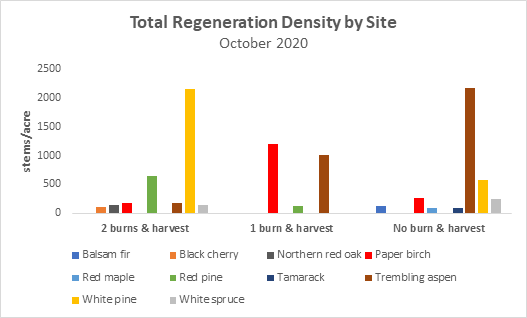
Figure 3. Total regeneration density by species and site in October 2020
NOTE: No regeneration check data available for the “control”, untreated area.
We believe differences between the treatment sites can be explained by 2 general effects of the burns: competition control and seedbed preparation.
Red pine and white pine differ in their seed bed requirements and light requirements.
Seedbed requirements: While both white and red pine establish best in mineral seedbeds, white pine can germinate and grow through duff and is a more common species to establish in unprepared sites. Red pine is more demanding of a mineral soil seedbed, as it doesn’t germinate or root well through a duff layer.
Light requirements: White pine has a higher tolerance for shade than red pine. It competes best in areas with partial shade. However, on sites with full sunlight, other vegetation can often outcompete white pine.
Following are summaries of regeneration results by treatment area:
Site treated with 2 burns and a seed tree harvest
This treatment has the highest density of white pine regeneration by far - 2,150 white pine stems/acre, compared to 583/acre for the area not burned and 0/acre for the site burned 1 time. The white pine on this site is also taller than other treatments - over half of the white pine regeneration is greater than 1 foot tall, whereas none of the stems on the other sites are over 1 foot tall. Red pine regeneration density is also highest on this site.
In addition to greater pine regeneration numbers, aspen competition was controlled far better on this site than on the other 2 treatments.
The combination of 2 burns and early fall (growing season) seed tree harvest in a year with a good seed crop clearly prepared a good seedbed and controlled vegetative competition better than the other treatments.
See Table 2 and Figure 3.
Site treated with 1 burn, hand white pine seeding and a seed tree harvest
This treatment has no white pine regeneration at all, and only a modest amount of red pine regeneration. Paper birch and aspen regeneration are dominant here. The hand seeding of white pine was done here due to the lack of white pine seed trees on this treatment site.
It is likely that in addition to competing vegetation not being controlled as well here as on the 2 burn site, the seedbed must also not have been well prepared. It seems likely that the single burn that was accomplished was not intense enough to reduce the duff layer or control competing vegetative competition adequately to achieve the site preparation goals.
See Table 3 and Figure 3.
Site treated with no burns and a seed tree harvest
This site has fair white pine regeneration (583 stems/acre), but no red pine regeneration. It also has by far the highest abundance of aspen regeneration. Apparently, the well-timed harvest activity with full-tree skidding must have adequately prepared the seedbed for white pine regeneration. However, aspen competition was not well controlled.
See Table 4 and Figure 3.
Plans for Future Treatments
Plans for the sites are to allow the stands to continue to develop for a few years.
Regeneration surveys in 2023, 2025, and 2029 will be used to assess for the need for budcapping, mechanical competition control, and pruning to mitigate any white pine blister rust risk.
If the 2023 regeneration survey shows inadequate white pine regeneration in any places, then the red pine regeneration in those places will be allowed to recruit into a red pine dominated stand. We will then remove the red overstory in a harvest to mitigate Diplodia risk in the new stand.
Costs and economic considerations
Costs
2009 Rx burn: $5,375 total = $ 537.50/acre (2009 dollars)
2013 Rx burn: $3,900 total = $ 300.00/acre (2013 dollars)
2014 hand seeding on 3.5 acres: $ 140 total = $ 40.00/acre (2014 dollars)
Total costs by treatment:
- 2 burns and seed tree harvest: $ 837.50/acre
- 1 burn, seed tree harvest and hand seeding: $ 340.00/acre
- No burn and seed tree harvest: $ 0.00/acre
NOTE: Post-establishment tending practices will probably consist of 1 brushsaw competition release of pine crop trees on the 2 burn area, and 2 brushsaw release treatments for the area burned once, and the area not burned. Average brushsaw release costs in this area are $150/acre.
Revenue
2013 timber sale on 13 acres: $22,016.00 total = $ 1,693.54/acre (2013 dollars)
2018 timber sale on 18 acres: $17,992.90 total = $ 999.60/acre (2018 dollars)
Total revenue: $40,009.90
Comparison to common practice of clearcut with reserves harvest, and herbicide and trenching site preparation:
Costs
Broadcast herbicide site prep. spraying: $ 128/acre
Site prep. trenching: $ 139/acre
Purchase 800 white pine seedlings/acre: $ 216/acre
Hand plant 800 seedlings/acre: $ 72/acre
Total cost: $ 555/acre
NOTE: Post-establishment tending practices will probably consist of 2 brushsaw competition release treatments of pine crop trees at $150/acre each.
Revenue
We would probably see 10% to 20% more revenue at harvest time due to the higher timber volume with a clearcut with reserves harvest rather than seed tree.
Other notes
We gratefully acknowledge the assistance of:
- Former MNDNR Forestry Technician Dan Hertle for study design assistance and administration of all silvicultural activities.
- Former MNDNR ECS Program staff Matt Huseby and Ashley Lehner for data collection and staff interviews used to document process steps.
- Former MNDNR ECS staff John Almendinger for study design assistance.
- MNDNR Silviculture Program Consultant Mike Reinikainen for review and editing assistance.
Summary/lessons learned/additional thoughts
We think this project was successful in naturally regenerating a productive stand of mixed pine. It highlights the value of preharvest competition control through prescribed fire and/or fall, full-tree harvest in areas where post-harvest herbicide is not an option.
The Deer River area has many stands of natural origin red and white pine that are inaccessible for summer site preparation, and/or within statutory boundaries that prohibit the use of herbicides for competition control. Projects such as this demonstrate that 2 rounds of burning in relatively quick succession followed by a well-timed seed tree harvest can provide adequate competition control and seedbed preparation to allow natural regeneration of conifer species. At a minimum, this treatment can allow us to get pine established, and delay the need for first competition release.
Additionally, the result of adequate white pine regeneration in the unburned stand tells us that a well-timed seed tree harvest with full-tree skidding can provide for a method of natural pine regeneration in areas and circumstances where prescribed fire isn’t feasible, or the risk is unacceptable.
Another key takeaway lesson is that harvest timing of fall during a good cone crop year is critical.
The timing of the final harvest in the unburned area was accomplished by using the greater flexibility afforded by a MNDNR Informal Timber Sale Permit. This allowed us to take advantage of an excellent cone crop of red and white pine. If we had used a Regular or Intermediate Auction Timber Sale Permit, the 3 year permit length and lack of strict seasonal harvest requirements would likely have resulted in a winter harvest, possibly during a poor seed crop year. A full tree harvest on frozen ground would not have had adequate scarification and produced less successful results.
Cost comparison
Total establishment costs were higher for the successful “2 burn site preparation with seed tree harvest” treatment, compared to the more standard practice of “herbicide and trenching site preparation and clearcut with reserves harvest” treatment.
Supplemental content
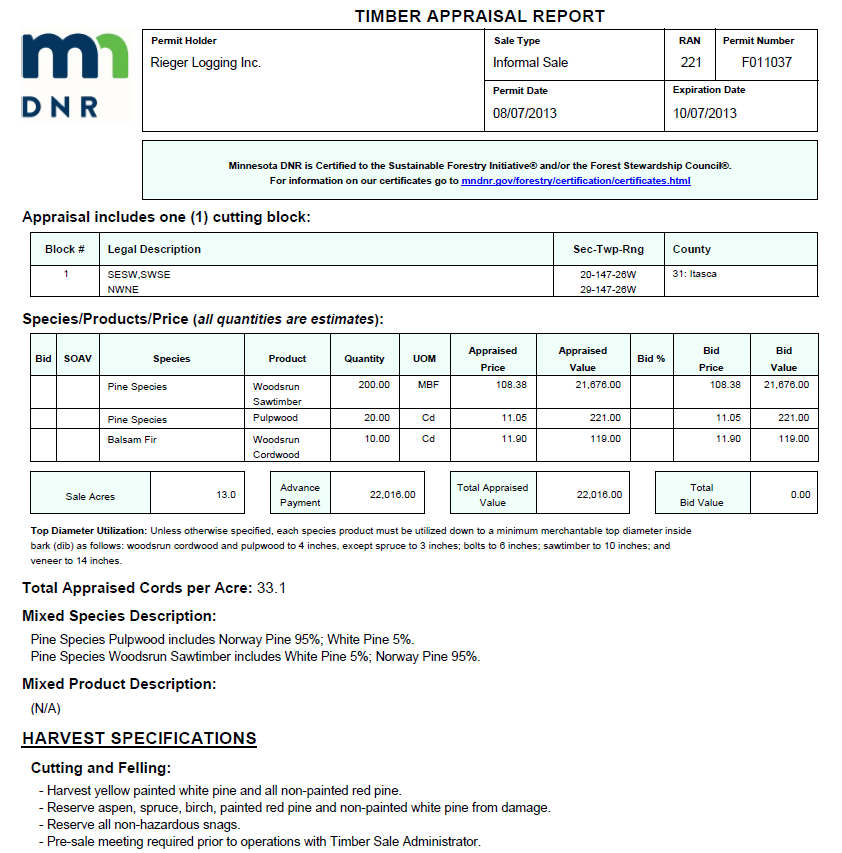
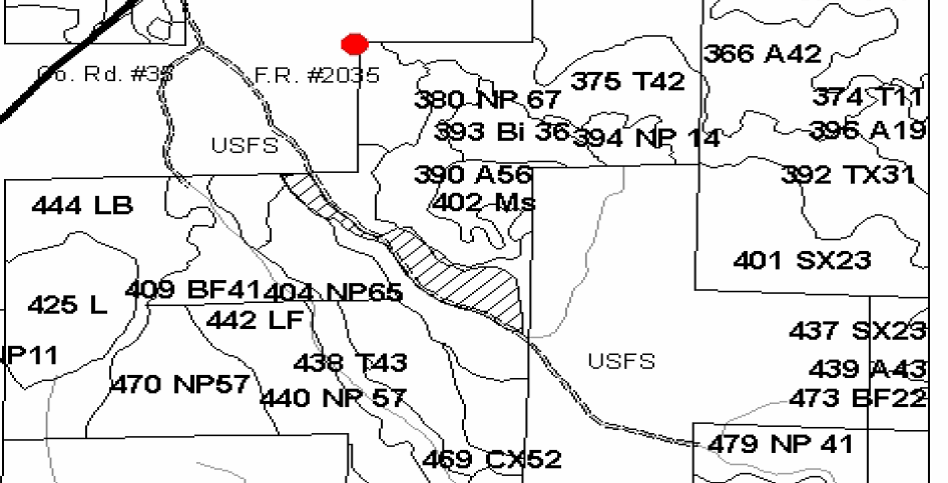
Supplemental figure 1: 2013 timber sale permit and map detail
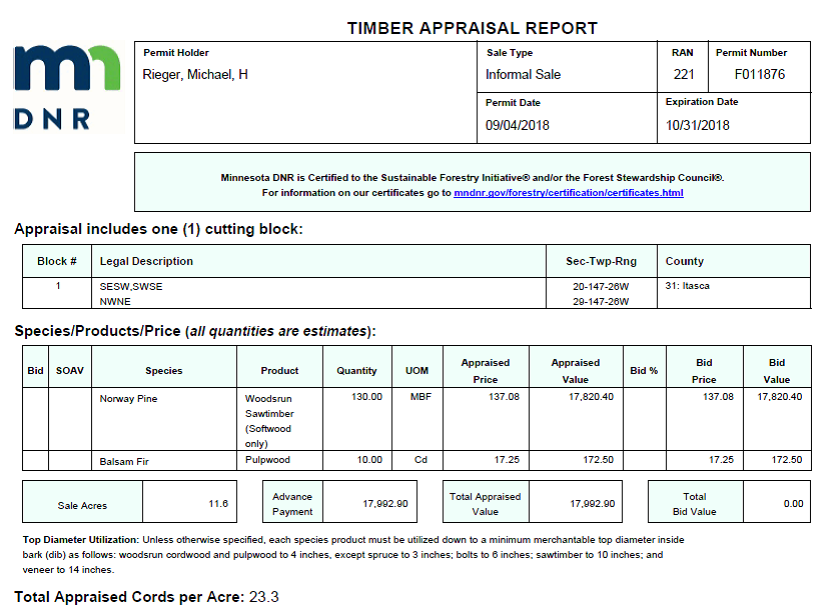
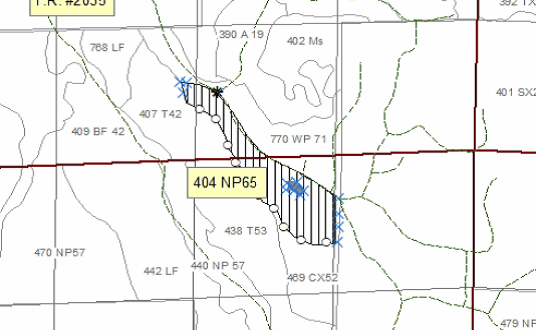
Supplemental figure 2: 2018 timber sale permit and map detail
